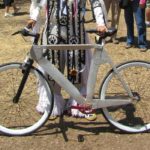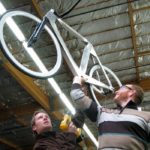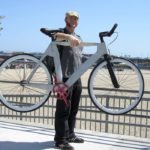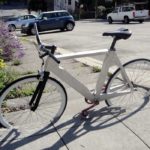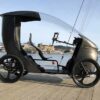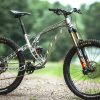In Ronin bicycle frame using sheet metal with rivets and glue
20.07.2020
3601
The Ronin bicycle frame is made of metal sheeting and fastened together with rivets and glue.
As Andy Davies takes his bicycle out on a ride, there’s a good bet that someone is sure to pull him over for a better view of his extraordinary vehicle. No surprise, his original bicycle frame is constructed with no welding required, consisting of several 0.024 inch (0.6 mm) sheets of 6061T6 aluminum that are folded like origami and held in place with rivets and glue.
“People pull me over first because of the way it looks,” Davis says of his bicycle. As Davis draws the inquisitive audience’s attention, he goes on to rationalize that the bent metal sheet in the frame of the bicycle makes it stronger and lighter to handle than any classic bicycle.
Indeed, when we enter a bike store, just what do we see? All sorts of different bike models with tubular frames, which may be steel, aluminum, carbon, or even bamboo. This is why the bike prototype, which was created by three San Francisco based businessmen who use another material for the frames – folded sheet metal by hand – is appealing. In fact, they had discovered a way to do sheet metal folding as simple as creating origami from paper. The other difference was joining the frame elements without being welded together using glue and rivets.
One secret that enables the makers at Ronin Metal Masters to hand-fold a neat assemblage of sheet metal is a special patent-pending punching pattern drilled into the materials. The holes enable manual shape of sheets of either aluminum, steel or titanium. The final form is given to the bicycle frame by glue joints, which are further strengthened by rivets.
Andy Davies, Rob Hannum and Mark Walsh are the trio of mechanical engineers who comprise the company known as the Ronin Metal Masters. After a number of experimentations using heavy weight paper, the current prototype was built from 0.024 inch (0.6 mm) thick sheets of 6061T6 aluminum alloy. The whole process took under three weeks, and the weight measurements of the resulting frame showed less than three pounds (1.4 kg).
Since welding is not necessary, however, there is also no risk of loosening the strength of the material where the seams are forming, a major problem in classic metal framing. This also implies that the framing would not have to be constructed in factories with commercial welding equipment. Developers assume that perforated sheets can ultimately be “printed” in an applicable service, and then riveted and spliced even in the conditions of the domestic workshop.
Rob Hannum, the project manager, is originally from Pennsylvania, where he has a business and mechanical engineering degree. He has spent 20 years in sheet metal design for several smaller companies, focusing on anything from solid-state equipment to automotive chassis.
Mark Walsh, is a native of Santa Cruz, California. His grandfather was an engineer and inventor. His father was also an engineer and worked on the original Bradley tanks. He began working with sheet metal himself when he was 17 years old. Once he finished high school, he continued to work in the sheet metal shops and high precision machining in Silicon Valley.
Andy Davies designed the prototype for this bike. He has a real passion not just for mechanicals and design, but for cycling as well. And his first effort to build an original bicycle was to create a two-passenger amphibious bicycle in the shape of a giant hot dog for the University of California Kinetic Racing team.
Having assembled a crew, the team began to develop products using their own technology. The emphasis was on weight and the durability of the frame of the bicycle. With a city like San Francisco, where so many residents take their bicycles with them wherever they go, including public transportation, it would be easy to lift and wear a bicycle with them. In addition, they are designed to be extremely durable, making it capable of handling a significant load. There are no welds, which enhances the structural rigidity and longevity of the design. Metal is bent and connected with rivets and glue, which is simple to realize and doesn’t demand any special qualifications from the maker.
The frame components of Avial e-Bikes is also be attached with glue and rivets and no welding is used. The main parts of the framework, though, use series-produced elements made of aircraft-grade aluminum alloys 6061 and 7075.
In detail https://www.facebook.com/RoninBicycleWorks

